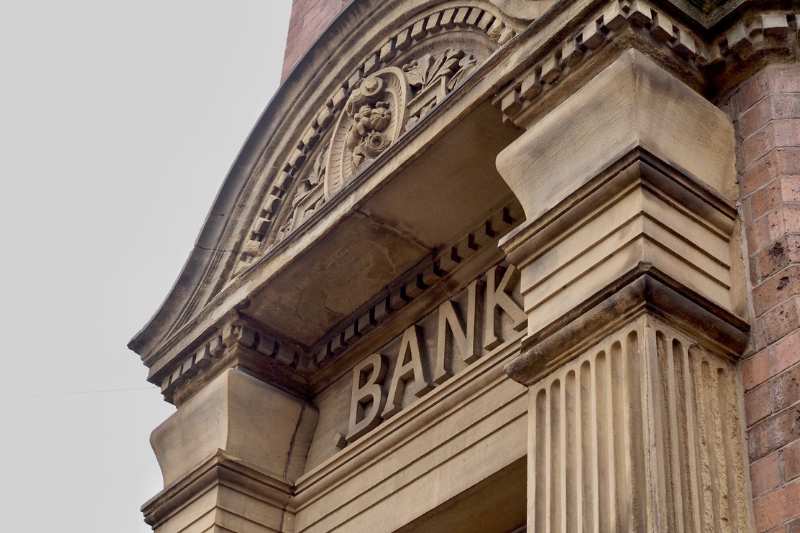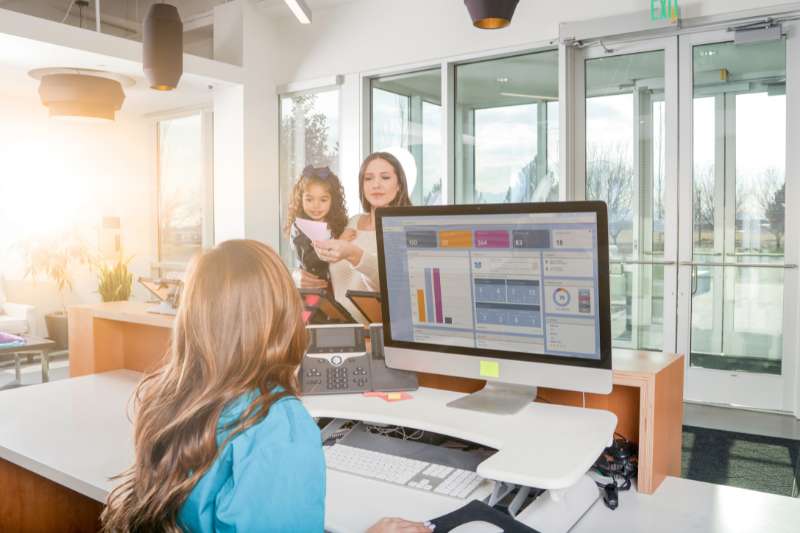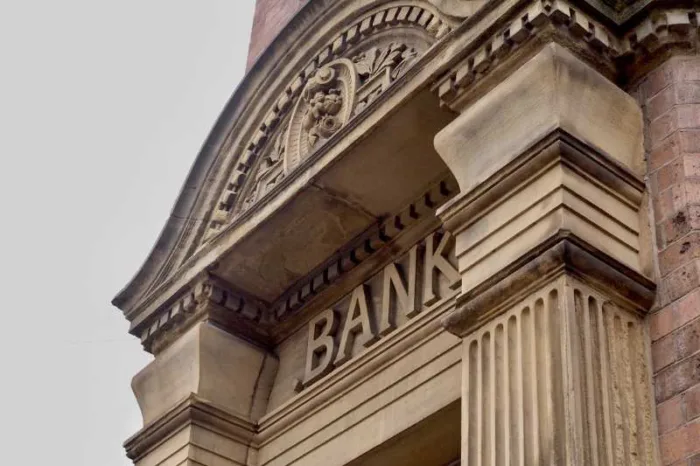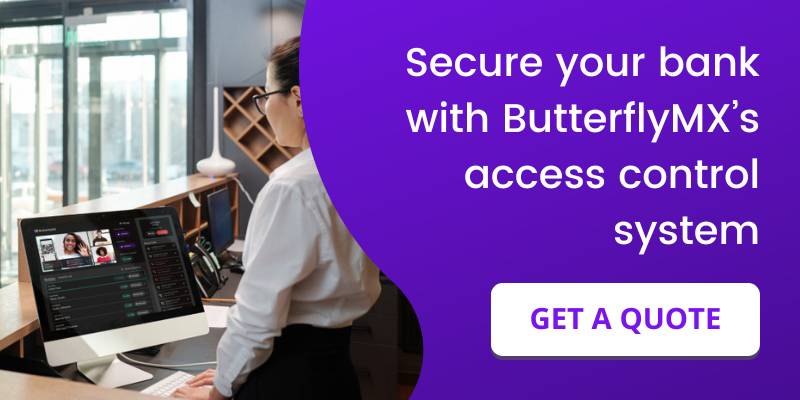Key takeaways
- Financial institutions face security challenges related to high-value assets, various entryways, and strict regulations.
- Banks are not the only organizations that benefit from access control; insurance companies, mortgage companies, and brokerage firms also need it.
- Mobile access, biometrics, and blockchain are trends for bank access control.
- Pair your access control with video surveillance, safes and vaults, and alarm systems.

Financial institutions like banks, credit unions, and mortgage companies face many security challenges. Fortunately, a bank access control system can address many of these hurdles.
Therefore, this guide outlines the best access control systems for banks and other financial institutions. Moreover, you’ll discover what security challenges banks face, the types of institutions that benefit from access control, and future trends to look out for. Finally, we’ll cover what other security systems your bank should implement.
This guide covers:
- 5 best bank access control systems
- Security challenges of financial institutions
- Types of institutions that need access control
- Future trends of bank access control
- What other security features should banks use?
5 best bank access control systems
When searching for an access control solution, you’ll find endless options, which is why we’ve listed the best systems below.
The five best bank access control systems are:
1. ButterflyMX
ButterflyMX is a cloud-based access control system company that enables users to access the property with their smartphones. Our flagship product, the video intercom, has been installed in more than 15,000 buildings and garnered over 40,000 five-star reviews.
Of course, the ButterflyMX access control system offers a property-wide solution, from your bank’s vestibule and offices to the parking garage and elevators. We enable mobile access through video intercoms, keypads, card and fob readers, vehicle readers, elevator controls, and more.
How ButterflyMX bank access control systems work
The ButterflyMX access control system can be implemented at your financial institution in the following ways:
- Vestibules. Install the video intercom to enable employee mobile access at your financial institutions’ main entryway and for customers to request access. The ButterflyMX video intercom can easily control vestibule doors so that your property’s outer door remains secure when an individual is entering. Additionally, you can implement the front desk station to see a live video feed of your video intercom, allowing you to see and speak to members of your bank before letting them inside.
- Offices and employee entrances. Use keypads and readers for individual rooms within your bank and private entryways for employees. ButterflyMX readers and keypads accept multiple credentials, such as our mobile app, PIN codes, key cards and fobs. This way, your employees can access the areas they need with the credentials they find the most convenient.
- Elevators. Install ButterflyMX elevator controls to manage who has access to various floors of your financial institution. Employees can use their key card or fob to reach the areas they need while you increase the security of highly sensitive areas throughout the building.
- Gates and parking garages. Manage access to your property’s parking lots or garages with a ButterflyMX vehicle reader. Authorized vehicles place a tag in the corner of their windshield, which the reader scans when approached. Then, it grants vehicle access without the driver having to scan a key card or input a code, reducing wait times and the risk of tailgating.
Learn how the ButterflyMX platform works:
2. Kisi
Kisi is a cloud-based access control system with an easily accessible online dashboard and mobile app. The app provides employees with access to authorized areas and supports key cards, fobs, and even hand gestures.
Kisi offers an intercom system with a sleek and simplistic design suitable for vestibules and main entryways to your financial institution. The system lets your employees see and speak with bank members when the button is pressed before granting them access.
3. LenelS2
LenelS2’s access control system is feature-rich and easily integrates with numerous other systems your bank or credit union may already use. The team at LenelS2 has designed a robust video management system with intrusion alarms that help you better understand your property’s data.
Their open APIs ensure that the cloud-based access control software works with over 200 certified products. Meanwhile, you can incorporate visitor management systems and human resource databases to create a comprehensive building operations platform.
4. Honeywell
While Honeywell is well known for its household products, such as thermostats and fire alarms, the company offers a broader range of security systems, such as access control. Honeywell’s access control solution ranges from keypads and readers to lobby kiosks and door hardware.
Honeywell’s readers include card readers, keypads, and biometric readers for properties with more sensitive areas to protect. Of course, Honeywell may not provide your bank with all the necessary access control solutions you need, which is why they’ve developed numerous integrations with other solutions, such as HID.
5. Genetec
Genetec’s access control system allows you to connect to other building systems your organization may use, such as video surveillance and alarms. As such, Genetec can offer an entirely cloud-based system or hybrid solution, depending on what works best for your business.
Genetec’s enterprise-grade access control system can be managed anywhere using a desktop or mobile device. In addition, you may consider their security center, which can be an on-premise or cloud-based solution. This allows you to connect numerous systems in one place for data-rich operations.
Security challenges of financial institutions
Given the nature of handling large amounts of money and financial data, banks, mortgage companies, credit unions, and similar organizations have unique security needs.
Your financial institution will face unique security challenges, such as:
- High-value assets. Financial institutions store money, highly sensitive customer data, and personal belongings. As a result, bank robberies and burglaries are common across the United States. So, access control systems are necessary for authorized personnel to easily access the resources they need while maintaining the safety of essential assets.
- Cybersecurity. In addition to physical security threats, banks face digital ones too. One of the primary reasons cyber attacks occur is for money, making your bank a prime target for hackers. Therefore, you need robust cybersecurity measures that pair nicely alongside your physical security for a holistic solution.
- Diverse access points. While the front door is the most used bank entryway, it’s likely the only one. For instance, you may have elevators to various floors, employee or side entrances, and potentially loading docks for armored trucks to enter. With such a diverse group of access points, you need an access control system that secures all of them and is managed from a single platform.
- Traffic volume. Banks see numerous people daily, from employees and customers to vendors and service providers. Managing access for such a diverse group of people is difficult, but the right system will streamline verifying and granting access to authorized individuals.
- Strict regulations. Most importantly, financial institutions must adhere to strict federal regulations to protect customers’ data and physical assets. Non-compliant organizations will face lofty fines and legal consequences, making access control an essential security feature for any bank.

Types of institutions that need access control
Access control systems go beyond benefiting banks. Rather, they’re best suited for several different financial institutions.
Financial institutions that require an access control solution include:
- Banks. Retail banks are the most common form, but access control is also necessary for other types of banks, such as commercial banks, investment banks, and cooperative banks.
- Credit unions. As member-owned nonprofit organizations, credit unions require holistic access control solutions to protect physical and digital assets, like cash deposits and credit card information.
- Brokerage firms. The nature of handling sensitive financial information, such as client information and transactions, calls for a bank access control system to manage who can enter server rooms, admin areas, and more.
- Insurance companies. With vast amounts of personal and financial data, insurance companies are a prime candidate for access control. Protecting access to data storage facilities and claims processing is critical.
- Mortgage companies. Handling loans and personal financial data prompts the need for access control. That way, you can protect clients’ deposits, financial records, and more.
- Savings and loan associations. Also known as S&L or thrift institutions, they must protect clients’ cash deposits and mortgage information from potential thieves, which access control is paramount in stopping.
Future trends of bank access control
Significant technological advancements are driving the future of bank access control systems, which will enhance security features and improve the effectiveness of daily operations.
Some growing trends in bank access control include:
Mobile access
Due to the prevalence of smartphones and people carrying them around anywhere they go, mobile access control has paved the way toward modern credentials. Banks reduce the costs of implementing physical credentials while increasing the security of their property by preventing the opportunity for key cards and fobs from being stolen or copied. Plus, mobile access control enables remote management, enabling owners and managers to edit permissions, review audit logs, and more anywhere.
Biometrics
Biometric authentication has grown in popularity among financial organizations that require a high-end and technologically advanced access control solution. This is mainly due to the technologies becoming easier and more affordable. Biometric access control systems for banks are ideal because they encompass credentials that can’t be stolen or copied, similar to mobile credentials.
Blockchain
While the access control we’re referring to is physical, digital access control is also essential, which is where blockchain technology comes into play. Blockchain can be used for more than cryptocurrency. It’s ideal for securing the integrity of sensitive data, such as financial records. Blockchain technology prevents data from being tampered with, ensuring the integrity of transactions. This technology will play a pivotal role in creating transparent and decentralized ledgers within the financial industry.
Artificial intelligence
AI and machine learning can enhance our lives in numerous ways, but access control will see significant boosts in effectiveness and efficiency. By quickly analyzing vast amounts of data, AI can identify patterns in access events and potential threats that a human may overlook. Thus, artificial intelligence can better protect banks and financial institutions.
What other security features should banks use?
Bank access control systems are only one security measure amongst several that your financial organization should be implementing.
Use access control alongside these other security features for your bank:
- Surveillance cameras. Continuous monitoring of your bank facilities will capture suspicious activities and pair well with access events. This way, your bank security cameras can better identify security breaches and deter potential threats.
- Alarm systems. Security alarms deter attempted robberies or break-ins, and fire alarms maintain employee and customer safety. These systems give your facilities a quick response to emergency events, maintaining a high level of safety for occupants.
- Security guards. The presence of a security guard is often enough to deter potential robbers, but they also serve as the first line of defense when perpetrators attempt to steal something. Your employees and customers will feel safer knowing you have boots on the ground for their safety.
- Safes and vaults. Banks and other financial institutions require safes and vaults to store lockboxes, money, and other valuable assets. These storage devices are highly secure and cannot be replaced by modern solutions.
- Cybersecurity measures. Finally, every financial institution should implement cybersecurity measures like firewalls, data encryption, and multi-factor authentication (MFA). This way, you’ll protect your customers from stolen data and your organization from serious harm.







